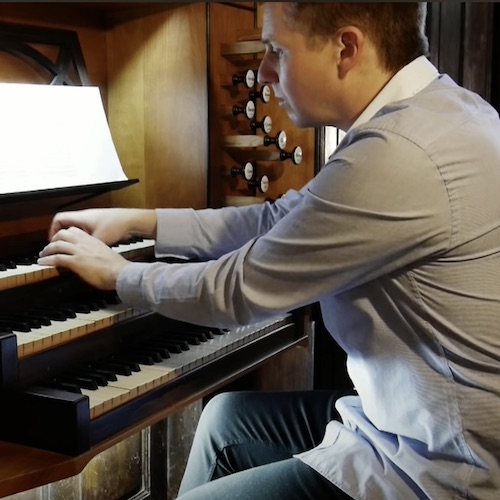DAUBLAINE & CALLINET
Church Saint-Nicolas Toulouse
Organ details
History
- 1845: Daublaine & Callinet
- 1857: Poirier & Lieberknecht
- 1944: Maurice Puget
- 2004: Orgues Giroud Successeurs, Jacques Nonnet
The instrumental part of the organ was classified as a historical monument on 4 May 1987.
In 1787, an organ was reported in the church of St. Nicholas, after lightning struck the bell tower. In the fourth year of the revolutionary calendar (1796), Jean-Baptiste Micot, organ builder at St-Sernin, "proceeded to the inventory of the organs belonging to the Republic". For St-Nicolas, he described an instrument with two manuals and pedal, with 19 stops and a "shrill sound and poor harmony". Abbot Jean Foix, for his part, recounted that in the church, which was closed to worship, "at fraternal gatherings of patriots..., the organ accompanied the revolutionary refrains". A new organ was therefore necessary. The decision was taken under the July Monarchy.
In the 1840s, no one in Toulouse knew how to repair or build a real organ. Dom Bedos, Isnard, L'Épine, Rabiny... had no successor. Since 1833, the Toulouse-born Aristide Cavaillé-Coll, followed by his father Dominique and his brother Vincent, had left the family workshop in the rue des Récollets to take on the commission of Saint-Denis near Paris.
In addition, in 1843, Daublaine-Callinet of Paris had been entrusted with the restoration of the organ of St. Paul's in Auterive, and was working on the reconstruction of the organs of St. Jacques in Montauban, of the basilica of St. Sernin, and of Cintegabelle. However, for all these sites, the delegate of Daublaine-Callinet was Émile Poirier living in Cintegabelle! It should be noted that he had learned to play the trumpet at the Royal School of Saumur, that he had worked with a printer using the lead-tin alloy used in organ pipes, and that he had become a specialist in this field in the factory. Thus, in this context of multiple works by Daublaine-Callinet, Émile Poirier proved to be a key player, and was the obvious choice for the organ of St-Nicolas!
When the Exposition at the Champs-Élysées opened in Paris in May 1844, the tenth of its kind, L'Illustration, the universal journal, emphasised: "Daublaine-Callinet maintains its reputation with dignity. It is known that Mr Barker, one of the company's directors, has succeeded in making the keyboards as soft to the touch as those of the pianos... The organ on display is destined for the church of St-Nicolas in Toulouse. A provisional presentation case was necessarily used for the event.
An estimate was submitted to the church by Félix Danjou, organist of the Paris cathedral, amounting to 25,000 francs (a blacksmith's salary of 3 fr/day). It was specified that "the case was at the expense of the church according to a drawing presented by the Maison Daublaine-Callinet". There would be the obligatory opinion of the architect of the city of Toulouse, Louis Delor 6 rue des Filatiers, for the plans of the gallery to be built and his agreement for the works of sculpture bell-towers, fleurons... These plans have not been found to date. However, we can be sure that the Gothic-effect sideboard which houses the musical part from Paris, a sideboard made by the Toulousan cabinetmaker Louis Lacassin and the sculptors Lupin and Rouzet, undoubtedly reflects the initial Parisian plan completed by Louis Delor. The Journal de Toulouse of 17 December 1844 "praised the architect and reported that the organ was finished. It could be heard on the 16th. And there is every reason to believe that the harmony was by Émile Poirier, the central figure.
While in Toulouse on the 16th "the splendid resources of the instrument were noted", a terrible event occurred the same day in Paris. The news arrived in Toulouse in the Journal of the 20th: "The named Barker, foreman of the Maison Daublaine, busy repairing the keyboard of the organ of St-Eustache, inadvertently set fire to the light he was using... In an instant, the entire organ was set ablaze...". This Daublaine-Callinet instrument was the one to be seen on site last May 1844 at the Expo, together with the organ of St-Nicolas on the stand! The inauguration of St-Nicolas by Alfred Lefébure-Wély de St-Roch was to be postponed to 28 February 1845 ("the audience was delighted when the learned artist performed 'L'Orage'"); the reception was in March. That same month, the Maison Daublaine-Callinet was bought by Ducroquet. Émile Poirier left the company, as did Frédéric Jungk and Nicolas Lieberknecht, and from then on "Messieurs les ecclésiastiques qui auraient quelques commandes à leur faire n'avaient qu'adresser place St-Aubin", as stated in La Gazette du Languedoc on 5 October 1845.
In 1857, the St-Nicolas factory was "warned that the organ, after twelve years, presented imperfections which were not due to its primitive construction, but to the usual effects of time... The instrument could be completed by the addition of stops for which the organ builder's foresight had left room on the windchests...; the blower had to be modified...". The work naturally fell to Émile Poirier! In 1868, "Sieurs Poirier and Lieberknecht drew up an estimate of repairs to be carried out, (because) the installation of the organ dated back to 1844: several bellows broke, dust paralysed the stops...". Poirier retired around 1880 (1887 death). The Pugets took over: 1857 Jean-Baptiste, Maurice 1919. From 2002 to 2004, restoration by Giroud Organs (inauguration on 11 March 2005 by Stéphane Bois and Michel Bouvard).
Michel Evrard
Multimedia library
Specification
| I. Positif intérieur C-f3 | II. Grand Orgue C-f3 | III. Récit expr. c-f3 | Pédalier C-f1 | |
| Flûte 8 Bourdon 8 Salicional 8 Salicional 4 Trompette 8 Euphone 8 Tremblant | Bourdon 16 Flûte 8 Prestant 4 Doublette 2 Fourniture II Cymbale III Cornet V Trompette 8 Clairon 4 | Flûte 8 Clarabella 8 Gambe 8 Flûte harmonique * 4 Octavin 2 Cor Anglais 16 Trompette * 16 Trompette * 8 Hautbois 8 (from f) Voix humaine 8 Tremblant Real octave coupler for trompettes, Flûte 8 and Flûte harmonique 4 * high pressure stops: 145 mm | Flûte 16 Flûte 8 Bombarde 16 Trompette 8 Clairon 4 | Tirasse G.O. Pos. / G.O. Anches Pos. Pos. / G.O. 16 Anches G.O. Expression Réc. Anches Réc. Réc. / G.O. 4 Anches Péd. Réc. / G.O. a1 = 448 Hz Equal temperament |


